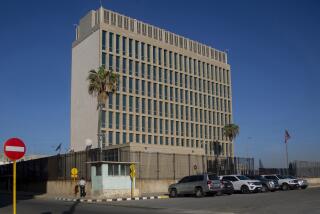Studies Pointing to Gulf War Illnesses
- Share via
With more than 100 studies in the works, the research effort into “Gulf War syndrome” is only now getting fully underway. But evidence that the deployment of U.S. troops during the Persian Gulf War was, indeed, unhealthy have shown up in several studies. Among the most notable:
Symptoms: An Iowa study reported in January compared 2,000 Iowa veterans who went to the Gulf to 2,000 Iowa veterans who did not. Based on personal accounts, the study found that 36% of the Gulf veterans had one or more medical problems, such as achy joints, thinking problems or asthma. That was about three times the rate of veterans who were not deployed.
A study of about 4,000 members of a Pennsylvania Air National Guard unit at Lebanon, Pa., found that those who had been deployed had a “significantly greater” incidence of chronic complaints, including digestive, thinking and fatigue. But examinations of the veterans did not find physical problems to explain their complaints.
Researchers studied 249 members of a Navy construction battalion and found illnesses, which were divided into six syndromes. Outside analysts found this research valuable for the data it provided, but some dispute the information had proved that the illnesses were caused by exposure to chemicals.
Mortality: The Department of Veterans’ Affairs looked at the death rate among 659,292 veterans who had been to the Gulf and compared it to 746,038 veterans who had not been there. It found that the deployed veterans had a death rate that was 9% higher; but the higher rate was primarily because of external causes, notably highway accidents. Disease-related deaths were lower than among veterans who did not go to the Middle East.
Hospitalization: The Defense Department compared the hospitalization records of 578,492 active duty personnel who went to the Gulf during the war to 699,792 who did not go, and found those who went to the war had lower rates of hospital treatment later.
Childbirth: Researchers studied the families of Gulf War veterans in Mississippi who feared they were suffering from an unusual cluster of birth defects. Researchers found the rates were normal, but the group, which included 59 children, was too small to draw general conclusions. Results of a broader study of birth defects are due soon.
CHEMICAL CULPRIT?
Two animal studies suggested that chemicals present in the war may have combined in a sort of toxic cocktail to produce the unexplained illnesses. The Pentagon in 1995 mixed two anti-insect chemicals--DEET and permethrin--with an anti-nerve gas medicine called pyrdistigmine bromide that was used by some troops.
At high concentrations, the resultant combination was lethal to rats. Also in 1995, Duke University researchers combined the same chemicals at slightly lower doses and found them highly toxic when injected in chickens.
But critics say the doses were too high to have any applicability for Gulf veterans.
More to Read
Sign up for Essential California
The most important California stories and recommendations in your inbox every morning.
You may occasionally receive promotional content from the Los Angeles Times.














